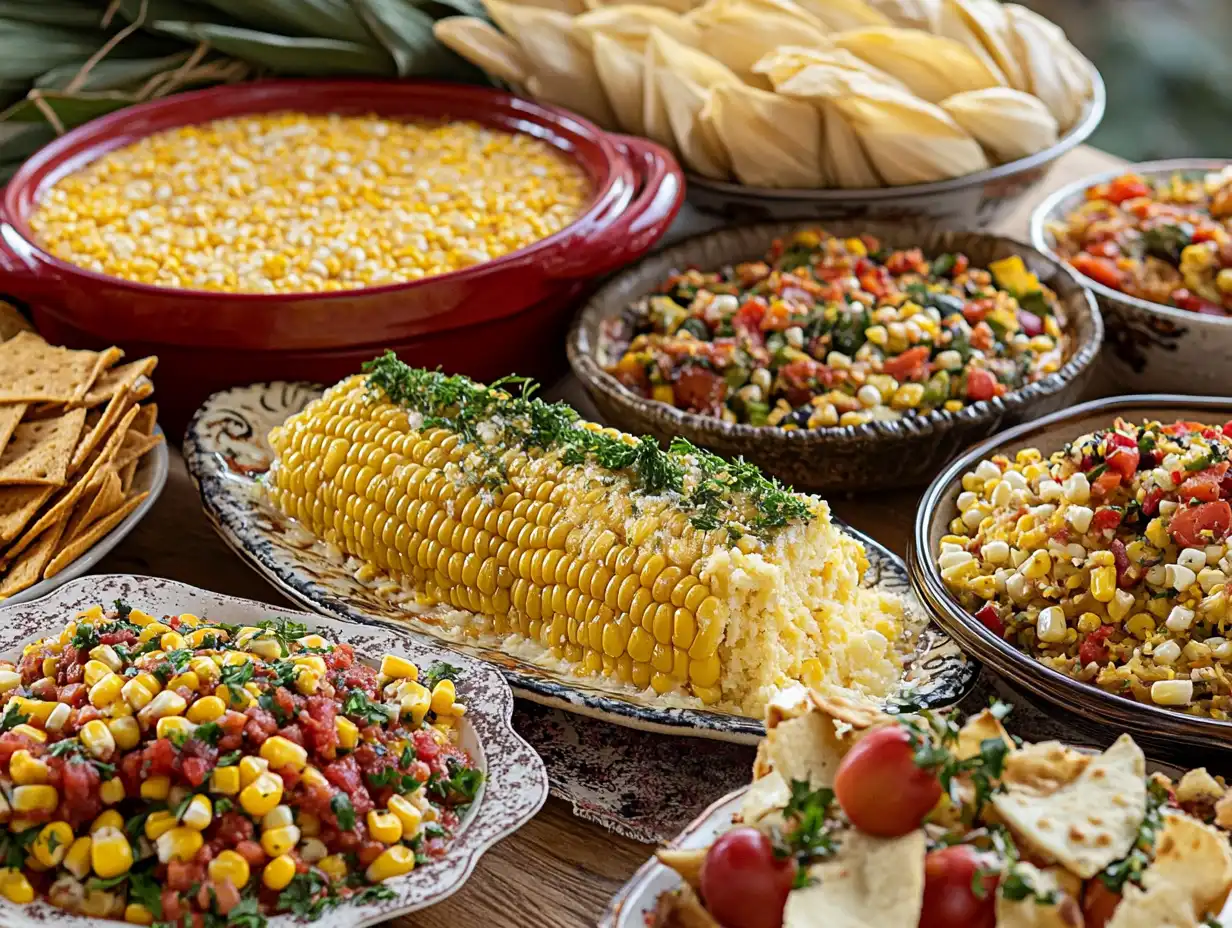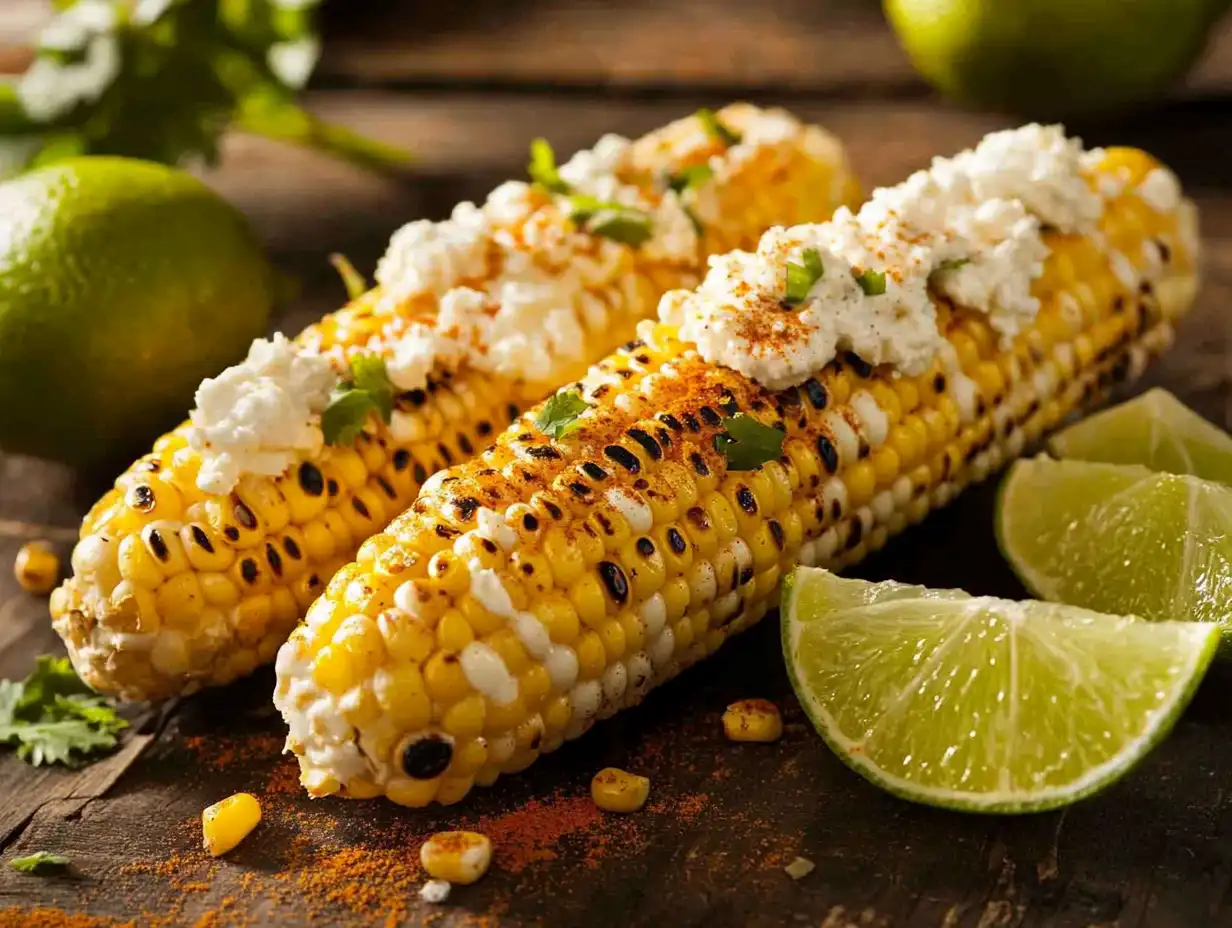When you think of corn, you might picture a simple, versatile ingredient—boiled, grilled, or added to your favorite recipes. But when you hear the word elote, you imagine the bustling streets of Mexico. Vendors serve this beloved dish steaming hot, covered with vibrant toppings, and bursting with flavor. At first glance, elote and corn might look similar, but these terms represent very different culinary concepts.
This article explores the difference between elote and corn. You’ll learn about their unique characteristics, cultural importance, and how people enjoy them worldwide. Whether you’re a food enthusiast or simply curious, this guide will offer clarity.
What is Corn?
Corn, or maize, serves as a staple crop that has nourished civilizations for thousands of years. It first grew in Central America, and farmers quickly spread it to other parts of the world because of its versatility. Today, corn exists in many forms, including sweet corn, field corn, and specialty types like popcorn.
People around the globe use corn in countless recipes. You can boil it, grill it, or process it into flour and syrup. Corn is also rich in carbohydrates, fiber, and essential vitamins, making it a nutritious and delicious food option.
Elote translates to “corn cob” in Spanish, but it represents much more than a simple vegetable. It stands as a cultural icon and a culinary masterpiece in Mexican cuisine. Traditionally, cooks grill whole ears of corn until the kernels develop a smoky, slightly charred flavor. After grilling, they coat the corn with a creamy layer of mayonnaise or sour cream, roll it in cotija cheese, and sprinkle it with chili powder. A squeeze of lime adds a refreshing finish.
Street vendors, known as eloteros, sell this dish across Mexico, often serving it fresh and hot to eager customers. While recipes for elote may vary by region, its essence always reflects the vibrant and flavorful spirit of Mexican culture.
Key Differences Between Elote and Corn
Elote and corn share a foundation but differ in preparation, consumption, and cultural significance.
Preparation
- Cooks typically boil, steam, or grill corn, serving it plain or with butter and salt.
- Elote undergoes a transformation through grilling and the addition of rich, flavorful toppings.
Consumption
- People often serve corn as a side dish or use it as an ingredient in soups, salads, and casseroles.
- Elote shines as a standalone dish, eaten directly from the cob, often in a celebratory or social setting.
Cultural Significance
- Corn serves as a global staple, appearing in countless cuisines worldwide.
- Elote embodies the vibrant street food culture of Mexico and often symbolizes togetherness and celebration.

Cultural Significance of Elote
Elote’s roots trace back to ancient Mesoamerican civilizations, where people revered maize as a sacred gift. Over centuries, Mexicans turned this staple crop into various culinary creations. Among these, elote emerged as a street food phenomenon, connecting communities through its flavors.
On the streets of Mexico, eloteros play an important role in preserving this tradition. With carts full of freshly grilled corn and colorful toppings, they create a sensory experience that celebrates culture and food. Elote appears at festivals, family gatherings, and casual street-side meals, representing much more than nourishment.
Varieties of Corn
Corn is a remarkably diverse crop, with different types suited for various culinary purposes. Here are some common varieties:
Field Corn
Primarily used for animal feed or industrial products, field corn is less sweet and not typically consumed fresh by humans.
Sweet Corn
This is the type of corn most people enjoy on the cob. Sweet corn is harvested while still tender and is known for its natural sweetness and juicy kernels.
Popcorn
A unique variety of corn, popcorn kernels have a hard outer shell that pops when exposed to heat, creating a light, fluffy snack.
Other specialty types include flint corn, used for decorative purposes and grinding into flour, and waxy corn, which is commonly used in processed foods.
How Elote is Made
The magic of elote lies in its preparation. Here’s a closer look at how this beloved dish comes to life:
Grilling the Corn
The process starts with fresh ears of corn, which are grilled over an open flame or hot coals. This imparts a smoky, slightly charred flavor that sets the stage for the toppings.
Adding Toppings
Once grilled, the corn is coated with a generous layer of mayonnaise or sour cream. It’s then rolled in crumbled cotija cheese, sprinkled with chili powder, and finished with a squeeze of lime juice. Some variations may also include butter, garlic, or even hot sauce for an extra kick.
Popular Recipes
While the traditional toppings are iconic, many recipes experiment with flavors, adding ingredients like crushed chips, cilantro, or even bacon bits. Each variation offers a new twist on a timeless favorite
Elote as a Street Food
Elote’s identity as a street food is central to its charm. Across Mexico and in Mexican communities worldwide, eloteros (corn vendors) serve this beloved treat from carts, often parked on busy streets or near local markets. The affordability, portability, and sheer flavor of elote make it a perfect street snack, enjoyed by people of all ages.
The popularity of elote has even spread beyond Mexico, becoming a highlight at food festivals and events in countries like the United States. Variations like “elote in a cup,” where the ingredients are layered into a portable container, make it even easier to enjoy this delicacy on the go. Despite these modern adaptations, the essence of elote as a celebration of simple, flavorful ingredients remains unchanged.
Health Benefits of Corn vs. Elote
Both corn and elote offer their own unique contributions to your diet. Here’s how they compare:
Nutritional Profile of Corn
Corn is naturally rich in carbohydrates, which provide energy, and contains dietary fiber that supports digestion. It’s also a good source of essential vitamins like B-complex vitamins and minerals such as magnesium and potassium. Plain corn, without any added fats or seasonings, is relatively low in calories.
Nutritional Profile of Elote
Elote, while still retaining the base nutrition of corn, becomes richer due to its toppings. The addition of mayonnaise, cheese, and butter significantly increases the calorie count, as well as the fat and sodium content. However, the toppings also add protein and certain vitamins, depending on the ingredients used.
Balancing Health and Flavor
While elote is a delicious treat, it’s best enjoyed in moderation if you’re mindful of your calorie intake. Opting for lighter toppings, like Greek yogurt instead of mayonnaise or a sprinkle of nutritional yeast instead of cheese, can make elote a bit healthier without sacrificing too much flavor.
Popular Recipes Featuring Corn
Corn’s versatility means it can star in countless recipes. Here are a few classics:
Corn on the Cob
A simple yet beloved preparation, corn on the cob can be boiled, grilled, or roasted, served with butter and a pinch of salt.
Creamed Corn
This rich, comforting dish combines corn kernels with cream, butter, and seasonings, making it a popular side for hearty meals.
Corn Soup
A light, flavorful soup made with fresh corn, broth, and herbs, often enhanced with a touch of cream for extra richness.
These recipes showcase the adaptability of corn, highlighting its ability to complement both simple and complex flavors.
How to Make Elote at Home
Making elote at home is simpler than you might think and allows you to customize the flavors to your liking. Here’s a step-by-step guide to recreating this beloved street food in your own kitchen.
Ingredients Needed:
- 4 ears of fresh corn (husked)
- 1/4 cup mayonnaise
- 1/4 cup sour cream
- 1/2 cup crumbled cotija cheese (or Parmesan as a substitute)
- 1 teaspoon chili powder
- 1 lime (cut into wedges)
- Optional: melted butter, hot sauce, or cilantro for garnish
Instructions:
- Prepare the Corn: Start by grilling the ears of corn on a hot grill or stovetop grill pan. Rotate them frequently to ensure even charring. This step adds a smoky depth of flavor.
- Mix the Sauce: In a small bowl, combine mayonnaise and sour cream. This will serve as the creamy base for your elote.
- Assemble the Elote: Once the corn is grilled, use a brush or spoon to coat each ear with the creamy mixture.
- Add the Toppings: Sprinkle the cotija cheese generously over the corn, ensuring it sticks to the sauce. Follow this with a dusting of chili powder.
- Finish with Lime: Serve each elote with a lime wedge. A squeeze of lime adds a refreshing tang that balances the richness of the toppings.
- Optional Extras: For those who enjoy extra heat or texture, drizzle the corn with hot sauce or sprinkle with crushed chips.
This recipe yields a vibrant and delicious elote that’s perfect for gatherings or simply enjoying as a treat.
Global Influence of Corn and Elote
Corn’s versatility has made it a global phenomenon, appearing in countless dishes across cultures. In addition to its prominence in Mexican cuisine, it plays significant roles in the following:
Corn Around the World
- United States: Cornbread, grits, and corn-on-the-cob are Southern staples.
- Italy: Polenta, made from ground cornmeal, is a traditional comfort food.
- Asia: Corn is a common addition to soups and stir-fries, particularly in Chinese and Korean cuisine.
Elote’s Spread Beyond Mexico
Elote’s popularity has transcended borders, with adaptations appearing in food trucks and restaurants worldwide. In the U.S., “Mexican street corn” has become a trendy menu item, often served in innovative formats like salads or as a pizza topping. Despite these creative twists, the heart of elote remains tied to its Mexican roots.

Frequently Asked Questions (FAQs)
Is elote healthier than plain corn?
Elote is generally richer in calories and fats due to its toppings. While plain corn is a healthier choice for everyday consumption, elote offers an indulgent treat that’s best enjoyed occasionally.
Can you use any type of corn to make elote?
Sweet corn is ideal for elote because of its tender kernels and natural sweetness. Field corn, which is starchier, is not recommended for this dish.
What are some elote alternatives?
For a lighter option, try “elote in a cup,” where the toppings are mixed with corn kernels in a bowl. You can also experiment with healthier toppings, like Greek yogurt or avocado.
Conclusion
The difference between elote and corn lies in the preparation, cultural context, and consumption style. While corn is a versatile staple enjoyed worldwide, elote elevates it into a flavorful and culturally rich dish that represents the heart and soul of Mexican street food. Whether enjoyed plain or adorned with toppings, both corn and elote hold a special place in global cuisine, celebrating simplicity and creativity.
For more recipes

